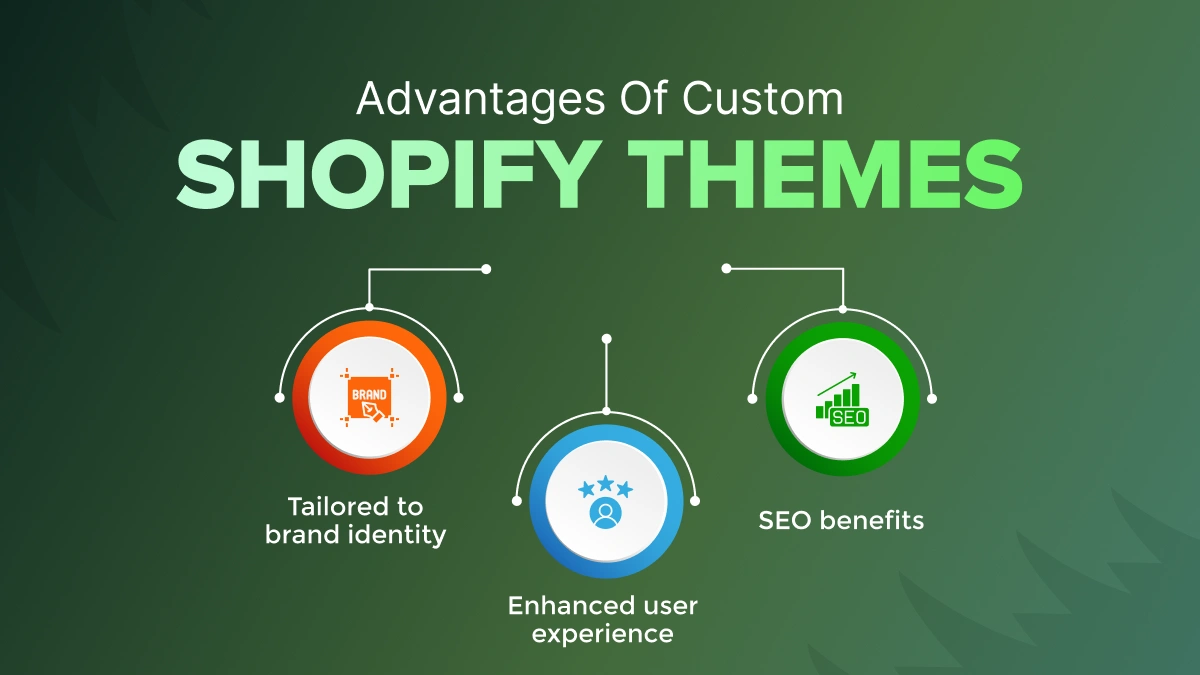Table of Contents
Shopify is the leading eCommerce platform and offers a foundation for businesses to establish their digital presence. However, to truly stand out in a competitive market, businesses are turning to custom Shopify themes.
This blog explores the significant impact of custom Shopify themes on driving sales and revenue, delving into the advantages they offer and the practical aspects of their implementation.
II. Advantages of Custom Shopify Themes
A. Tailored to brand identity
Custom Shopify themes for sales growth enable businesses to seamlessly integrate their brand logos and colors into the design. This consistency enhances brand recognition and fosters a sense of trust among customers.
Generic Themes might create a uniform look for Several online stores, diluting the uniqueness of a brand. Customizing Shopify Themes for Better Sales, on the other hand, enables businesses to incorporate distinctive design elements that set them apart from the competition.
B. Enhanced user experience
A personalized theme facilitates intuitive navigation, ensuring that visitors can easily find what they are looking for, streamlined menus, strategically placed call-to-action buttons, and user-friendly layouts contribute to a positive browsing experience.
I.Mobile Responsiveness
With the increasing prevalence of mobile shopping, having a responsive design is crucial. Custom Shopify themes are built to be mobile-friendly, ensuring a seamless and enjoyable experience for users on various devices.
II. Improved Page Loading Times
Slow-loading pages can drive potential customers away. Custom themes are optimized for performance, leading to faster page loading times. This not only improves user experience but also positively impacts search engine rankings.
C. SEO benefits
I. Optimized for search engines
Custom Shopify themes can be tailored with SEO best practices in mind. This includes optimizing meta tags, image alt text, and other elements that contribute to better search engine visibility.
II. Higher rankings and visibility
Search engines favor websites with well-optimized and user-friendly designs. Custom themes contribute to higher search engine rankings, increasing the likelihood of attracting organic traffic and potential customers.
III. How to Implement a Custom Shopify Theme?
Customizing Shopify Themes for Better Sales involves a thoughtful blend of technical proficiency, design acumen, and strategic planning. Let’s explore the key steps to implement custom Shopify themes.
A. Hiring a Professional Shopify Expert
Creating a custom Shopify theme needs a blend of technical expertise and design finesse. If you lack the necessary skills or time, hiring a Professional Shopify expert or designer is a prudent choice. While hiring Shopify experts, evaluate the following points.
I. Identify your Needs:
Before hiring a professional, clearly outline your needs. Understand the features and design elements you need in your custom theme. This will help you communicate effectively with potential designers or developers.
II. Search for Shopify Experts:
Shopify maintains a directory of certified experts. Browse through their profiles, considering their expertise, past projects, and client reviews. This will give you a good idea of their reliability and capabilities.
III. Interview Candidates:
Conduct interviews to assess their understanding of your project and their problem-solving skills. Ask for references from previous clients and evaluate the compatibility of their work style with your project requirements.
IV. Check Portfolios:
A portfolio is a reflection of a developer’s or designer’s capabilities. Examine their previous work to ensure they can deliver the level of customization and design you desire for your Shopify store launch.
V. Discuss Budget and Timeline:
Clearly define your budget and timeline expectations. Discuss these aspects with potential candidates to ensure alignment. A transparent conversation about costs and deadlines will avoid misunderstandings later in the project.
B. Customization Options Within the Shopify Platform
Shopify offers a robust set of tools and features for customizing themes without advanced coding skills. Also, Shopify Themes Customization Techniques includes these built-in options that can enhance the appearance and functionality of your online store.
I. Theme Customizer:
Shopify’s Theme Customizer allows you to modify various aspects of your theme, such as colors, fonts, and layout. Experiment with different combinations until you achieve the desired look and feel.
II.Sections and Blocks:
Take advantage of Shopify’s section-based structure. Sections and blocks enable you to customize specific parts of a page independently. This flexibility empowers you to create unique layouts for different pages.
III.Custom Code:
For more advanced users, Shopify allows direct access to theme code. This feature is beneficial for implementing custom functionalities or making precise design adjustments. However, exercise caution, and ensure you have a backup before making significant changes.
IV. App Integrations:
Explore the Shopify App Store for apps that complement your customization needs. Whether it’s adding a unique product display or integrating social media feeds, apps can extend the functionality of your theme without extensive coding.
V. Mobile Responsiveness:
Ensure your custom theme is mobile-friendly. Shopify themes are designed to be responsive, but it’s crucial to test your customization across various devices to guarantee a seamless user experience.
C. Maintenance and updates for ongoing optimization
Maintaining custom Shopify themes is an ongoing process that involves regular updates and optimizations. Ignoring this aspect can lead to security vulnerabilities and a suboptimal user experience.
I.Regular Backups:
Before making any updates, always create a backup of your theme. This precautionary step ensures you can revert to a previous version if issues arise during the update process.
II.Stay Informed About Updates:
Keep track of Shopify updates and theme-specific announcements. This information is vital for understanding new features, bug fixes, and security patches. Subscribe to newsletters or forums where Shopify developers share insights.
III.Test Updates in a Sandbox:
Before applying updates to your live store, test them in a sandbox environment. Shopify provides a development store for testing purposes. This allows you to identify and resolve any compatibility issues before affecting the user experience.
Iv. Security Measures:
Implement security best practices to protect your online store and customer data. Regularly update passwords, enable two-factor authentication, and stay informed about potential security threats. Shopify actively addresses security concerns, but your proactive measures are equally important.
V. Performance Optimization:
Regularly assess the performance of your custom theme. Optimize images, minimize code, and leverage content delivery networks (CDNs) to ensure fast page loading times. A swift and responsive online store design enhances user satisfaction and search engine rankings.
Conclusion:
By understanding the significance of these themes and taking the necessary steps to implement and maintain them, businesses can position themselves for sustained success in the dynamic world of e-commerce. As the digital landscape evolves, custom Shopify themes stand as a strategic investment for those aspiring to thrive in the online marketplace.
You can check out our top Custom Shopify Themes for Sales that will help drive your business growth. Also, Shine Dezign Infonet offers a customized experience that can help you to tailor your brand identity to your convenience.


















